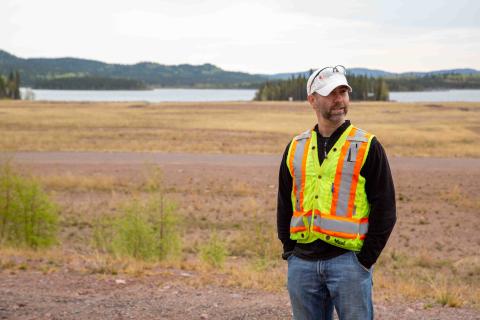Inside SRC
Solution mining is one way producers can mine potash deep below the earth’s surface. Cooling ponds can become contaminated in the extraction process, which can result in the production of hydrogen sulfide - a dangerous and highly destructive chemical. Learn how researchers are finding ways to control it.
Advanced mining technologies, like sensor-based sorting, have the potential to address challenges the mining industry now faces, including declining ore grades, water shortages and increasing environmental regulations. Learn how we're using sensor-based sorting to develop, test and pilot processes for industry.
SRC's Project CLEANS team travelled to five uranium mine sites in northern Saskatchewan that had been abandoned in the 50s and 60s to conduct preliminary site investigations as part of large-scale remediation project. Learn about the challenges of visiting these sites and the work being done to clean them up.
Understanding what goes on inside a slurry pipeline is a complex matter. SRC's Gamma Ray Tomography unit uses multiple gamma-ray sources and sensors to produce real-time images of the density of the pipeline contents at top-notch speeds.
Ian Wilson leads a team of scientists, engineers and project managers who are remediating 37 abandoned uranium mine sites scattered across remote areas of northern Saskatchewan. Learn what makes this project and the remediation team unique.
When many of uranium mines in northern Saskatchewan were abandoned in the 1950s and 60s, openings to mine workings were left without proper closures and pose a risk to public safety. SRC has been working with local contractors and consulting engineers to build proper mine closures. There are several methods available, depending on the type of opening and the site conditions.
When a mine operation evaluates how well its plant is performing, it’s important they have reliable, accurate data to compare the present to the past. A plant audit can provide clarity about how a plant is performing as a whole to help improve recovery rates. Learn more.
You may be familiar with the gadgets a home 3-D printer can produce, but engineering 3-D printed parts for industry is a different game. With strength and stiffness requirements, load-carrying parts and mechanical components are slow to find their way to critical applications. Learn more.
The Internet of Things (IoT) connects ordinarily mundane devices to the Internet to give you greater knowledge and control of their functions.The Industrial Internet of Things (IIoT) is simply the IoT in an industrial setting. But unlike consumer-grade appliances like refrigerators and toasters, industrial machinery and scientific instrumentation require a few more checks and balances.
The Nicholson Mine was the first uranium mine to be developed in Saskatchewan. In 1949, it was the only active uranium mine in Canada outside the Northwest Territories. By 1959, the Nicholson ore body had been essentially depleted, but the Nicholson Mine had played its role in helping Canada become one of the largest uranium producers in the world. Learn more about the challenges of developing and operating this mine.










